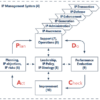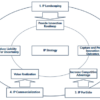Training at TESAT-Spacecom: Quality standard compliant IP management for communication technology
Satellite communication has two main components: the ground segment, which consists of fixed or mobile transmission, reception, and ancillary equipment, and the space segment, which primarily is the satellite itself. A typical satellite link involves the transmission or uplinking of a signal from an Earth station to a satellite. The satellite then receives and amplifies the signal and retransmits it back to Earth, where it is received and reamplified by Earth stations and terminals. Satellite receivers on the ground include direct-to-home (DTH) satellite equipment, mobile reception equipment in aircraft, satellite telephones, and handheld devices.
The idea of communicating through a satellite first appeared in the short story titled “The Brick Moon,” written by the American clergyman and author Edward Everett Hale and published in The Atlantic Monthly in 1869–70. The story describes the construction and launch into Earth orbit of a satellite 200 feet (60 metres) in diameter and made of bricks. The brick moon aided mariners in navigation, as people sent Morse code signals back to Earth by jumping up and down on the satellite’s surface.
What is a satellite?
A satellite is basically a self-contained communications system with the ability to receive signals from Earth and to retransmit those signals back with the use of a transponder — an integrated receiver and transmitter of radio signals. A satellite has to withstand the shock of being accelerated during launch up to the orbital velocity of 28,100 km (17,500 miles) an hour and a hostile space environment where it can be subject to radiation and extreme temperatures for its projected operational life, which can last up to 20 years. In addition, satellites have to be light, as the cost of launching a satellite is quite expensive and based on weight. To meet these challenges, satellites must be small and made of lightweight and durable materials. They must operate at a very high reliability of more than 99.9 percent in the vacuum of space with no prospect of maintenance or repair.
The main components of a satellite consist of the communications system, which includes the antennas and transponders that receive and retransmit signals, the power system, which includes the solar panels that provide power, and the propulsion system, which includes the rockets that propel the satellite. A satellite needs its own propulsion system to get itself to the right orbital location and to make occasional corrections to that position. A satellite in geostationary orbit can deviate up to a degree every year from north to south or east to west of its location because of the gravitational pull of the Moon and Sun. A satellite has thrusters that are fired occasionally to make adjustments in its position. The maintenance of a satellite’s orbital position is called “station keeping,” and the corrections made by using the satellite’s thrusters are called “attitude control.” A satellite’s life span is determined by the amount of fuel it has to power these thrusters. Once the fuel runs out, the satellite eventually drifts into space and out of operation, becoming space debris.

The story of TESAT – a German company with 60 years of experience
Over the course of six decades, TESAT has developed in-depth expertise in manufacturing of payload equipment for communication satellites and has established itself as a clear European market leader. On its 60,000m² premises in Backnang, Germany, about 1,100 employees develop, assemble, integrate, and test systems and equipment for telecommunication via satellite. To date, more than 700 space projects have been completed.
Their product offerings encompass highly reliable equipment as for example the travelling wave tube amplifiers, multiplexers, waveguide switches, and modulators, which along with complete systems are delivered globally to all leading satellite manufacturers. Therefore, they offer the complete communication technology necessary to for example emit television signals over the antenna of a satellite to each household. More than half of all communication satellites in orbit have Tesat equipment on board.
TESAT is a true one-stop-shop not only for communication and amplifier product solutions, but also in a matter of accompanying services. Here we differentiate between so-called operations services, engineering services and EEE services. The former refers to skills regarding to the complete product life cycle, starting at product design up to manufacturing, several tests and final quality inspection. Let’s take a closer look at a pick of the near infinite list of different skills.
Starting with TESAT’s OPERATIONS SERVICES, the fully automated microwave factory has to be mentioned. With all the high-skilled experts, this department has an accumulated experience in hybrid microwave manufacturing of more than 80,000 complex LTCC modules. This department makes use of man-less ghost-shifts (24/7) with a First Pass Yield of more than 92 % resulting in a capacity of more than 2 Million hybrids a year.
As operations takes over as soon as there is a ready-to-build production design, TESAT’s ENGINEERING SERVICES take the lead. A broad range of engineering experts are responsible for the whole product portfolio of TESAT and all further developments. This includes all areas from microwave to semiconductor development, all active, passive and optical communication systems up to complete payloads and subsystems (e.g. H2SAT). Apart from product development, TESAT’s engineering skills also cover software development, digital design and also in-orbit services of the own brand laser communication terminals within the European Data Relay Satellite Service and the European Copernicus mission.

Telecommunication standards and the relationship between patents and standards
The Telecommunication Standards collection contains technical data from US & European standards developing organizations (SDOs) that drive the delivery of voice and data transmissions across telephony and physical network systems. Standards for the design, installation and testing of telecom systems in commercial and residential buildings are available for purchase separately and are categorized by telecom systems, fiber optic and premises wiring and safety. These telecommunication technical specifications enable you to:
- Ensure consistency across networks
- Maintain technical compatibility
- Manage risk
Patents provide incentives for research and development, and facilitate knowledge transfers. Standards ensure the rapid diffusion of technologies and the interoperability between products.
Many standards are based on patented technologies. For example, the mobile telecommunications industry is driven by a heavy reliance on standardisation, which comprises a great number of innovations protected by patents. 2G (GSM), 3G (UMTS), 4G (LTE), 5G and WiFi networks rely on thousands of patented technologies to work. Such communication standards are also key for the development of the hyper-connected society, for example in the field of the Internet of Things in sectors such as consumer electronics, the automotive industry and the electricity grid industry.
Organisations engaged in standard setting have developed rules and practices to ensure the efficient licensing of patents that are essential for their standards (‘standard essential patents’). A smooth licensing environment is essential to the success of a standard. It helps to achieve broad and rapid diffusion of innovation and to give patent holders an adequate return on investment in research and development (R&D). It also gives all users of the standard fair access at a reasonable cost.
What is Intellectual Property Risk Management?
It is the process of identifying, analyzing and responding to risk factors related to IP throughout the life of an IP right. Proper risk management implies control of possible future events and is proactive rather than reactive. Proper IP Risk Management will reduce not only the likelihood of an adverse event occurring, but also the magnitude of its impact on the business. If risk management is set up as a continuous, disciplined process of problem identification and resolution, then the system will easily supplement other systems. This includes; organization, planning and budgeting, and cost control. Surprises will be diminished because emphasis will now be on proactive rather than reactive management.
IP risk management is about ensuring that the business really understands its IP related risks, and then mitigates pro-actively. The rationale for this may be driven by the need for the freedom to use technologies already in use or being considered for use in the company’s products, but there are many other reasons why businesses need to take IP risk management seriously.
Truly understanding the origins of many of the IP risks facing a company is a key aspects of proper and professional IP risk management. Finally it is important not to underestimate or exaggerate the risks associated with IP. As IP relates to innovation and creativity, it can sometimes be an emotive subject and some care is needed. How to manage new digital IP risks with IP-design was the topic of a training by Prof. Wurzer at TESAT-spacecom.
Explore more about TESAT-spacecom and their innovative products:



